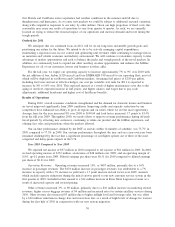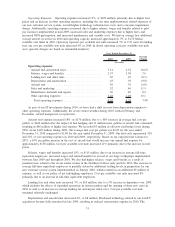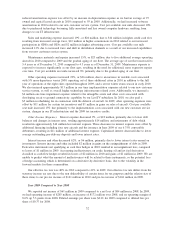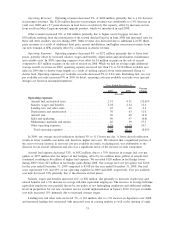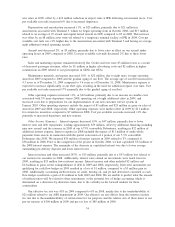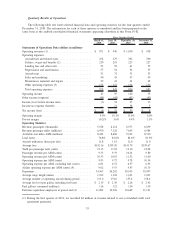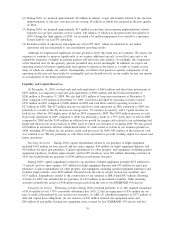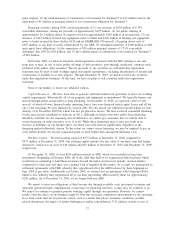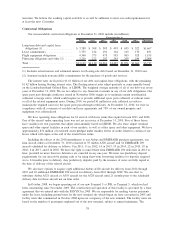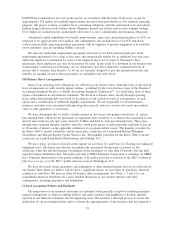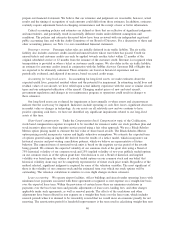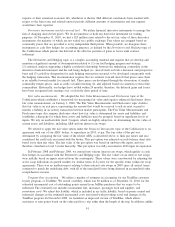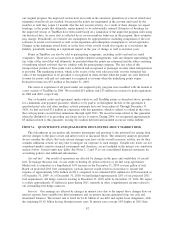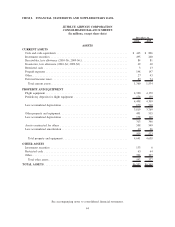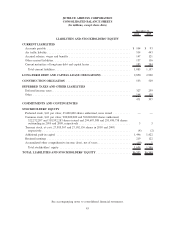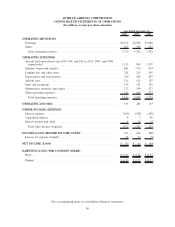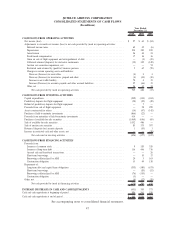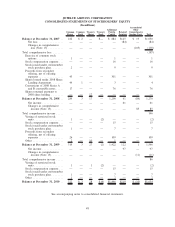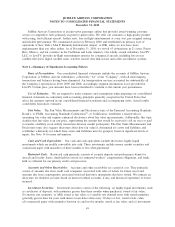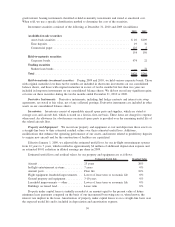JetBlue Airlines 2010 Annual Report Download - page 49
Download and view the complete annual report
Please find page 49 of the 2010 JetBlue Airlines annual report below. You can navigate through the pages in the report by either clicking on the pages listed below, or by using the keyword search tool below to find specific information within the annual report.prepare our financial statements. We believe that our estimates and judgments are reasonable; however, actual
results and the timing of recognition of such amounts could differ from those estimates. In addition, estimates
routinely require adjustment based on changing circumstances and the receipt of new or better information.
Critical accounting policies and estimates are defined as those that are reflective of significant judgments
and uncertainties, and potentially result in materially different results under different assumptions and
conditions. The policies and estimates discussed below have been reviewed with our independent registered
public accounting firm and with the Audit Committee of our Board of Directors. For a discussion of these and
other accounting policies, see Note 1 to our consolidated financial statements.
Passenger revenue. Passenger ticket sales are initially deferred in air traffic liability. The air traffic
liability also includes customer credits issued and unused tickets whose travel date has passed. Credit for
unused tickets and customer credits can each be applied towards another ticket within 12 months of the
original scheduled service or 12 months from the issuance of the customer credit. Revenue is recognized when
transportation is provided or when a ticket or customer credit expires. We also defer in the air traffic liability,
an estimate for customer credits issued in conjunction with the JetBlue Airways Customer Bill of Rights that
are expected to be ultimately redeemed. These estimates are based on historical experience and are
periodically evaluated, and adjusted if necessary, based on actual credit usage.
Accounting for long-lived assets. In accounting for long-lived assets, we make estimates about the
expected useful lives, projected residual values and the potential for impairment. In estimating useful lives and
residual values of our aircraft, we have relied upon actual industry experience with the same or similar aircraft
types and our anticipated utilization of the aircraft. Changing market prices of new and used aircraft,
government regulations and changes in our maintenance program or operations could result in changes to
these estimates.
Our long-lived assets are evaluated for impairment at least annually or when events and circumstances
indicate that the assets may be impaired. Indicators include operating or cash flow losses, significant decreases
in market value or changes in technology. As our assets are all relatively new and we continue to have
positive operating cash flows, we have not identified any significant impairments related to our long-lived
assets at this time.
Share-based compensation. Under the Compensation-Stock Compensation topic of the Codification,
stock-based compensation expense is required to be recorded for issuances under our stock purchase plan and
stock incentive plan over their requisite service period using a fair value approach. We use a Black-Scholes-
Merton option pricing model to estimate the fair value of share-based awards. The Black-Scholes-Merton
option pricing model incorporates various and highly subjective assumptions. We estimate the expected term
of options granted using an implied life derived from the results of a lattice model, which incorporates our
historical exercise and post-vesting cancellation patterns, which we believe are representative of future
behavior. The expected term of restricted stock units is based on the requisite service period of the awards
being granted. We estimate the expected volatility of our common stock at the grant date using a blend of
75% historical volatility of our common stock and 25% implied volatility of two-year publicly traded options
on our common stock as of the option grant date. Our decision to use a blend of historical and implied
volatility was based upon the volume of actively traded options on our common stock and our belief that
historical volatility alone may not be completely representative of future stock price trends. Regardless of the
method selected, significant judgment is required for some of the valuation variables. The most significant of
these is the volatility of our common stock and the estimated term over which our stock options will be
outstanding. The valuation calculation is sensitive to even slight changes in these estimates.
Lease accounting. We operate airport facilities, offices buildings and aircraft under operating leases with
minimum lease payments associated with these agreements recognized as rent expense on a straight-line basis
over the expected lease term. Within the provisions of certain leases there are minimum escalations in
payments over the base lease term and periodic adjustments of lease rates, landing fees, and other charges
applicable under such agreements, as well as renewal periods. The effects of the escalations and other
adjustments have been reflected in rent expense on a straight-line basis over the lease term, which includes
renewal periods when it is deemed to be reasonably assured that we would incur an economic penalty for not
renewing. The amortization period for leasehold improvements is the term used in calculating straight-line rent
40


